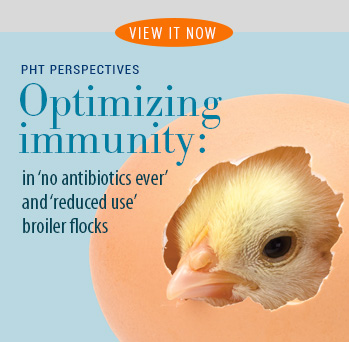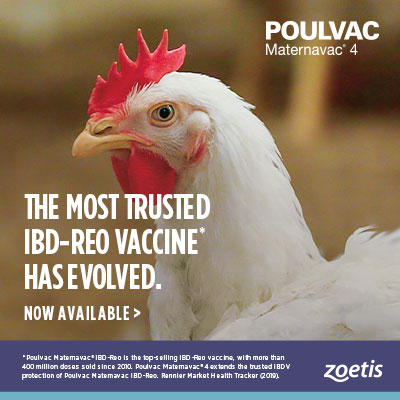Routine testing for IB vaccine takes can improve performance and profits
An interview with Manuel Da Costa, DVM, PhD, Associate Director, Outcomes Research, Zoetis
Q: Why is testing for infectious bronchitis (IB) vaccine take important?
MD: Testing for vaccine take can lead to identification of problems that can interfere with disease protection and, ultimately, flock performance. It can help ensure you’re getting the most from your vaccines.
Q: How do you test for IB vaccine take?
MD: We collect either tracheal swabs or tracheal tissue samples and test them for IB vaccine presence using real-time polymerase chain reaction (Q-PCR). Q-PCR is a molecular technique that amplifies the genetic material present in the sample in cycles (cycle threshold value = Ct), and the results are measured by fluorescence detection. Fewer cycles needed will yield a lower Ct value, which indicates a higher presence of vaccine or virus.
Q: What kind of problems are revealed by testing for vaccine take?
MD: In short, it shows if the vaccine(s) is being administered and replicating in the bird properly. A lack of vaccine detection can be related to improper handling during preparation or suboptimal application. Nowadays, we can measure each individual serotype (if birds are receiving more than one IB virus serotype), which generally helps understanding if it is an application or vaccine-preparation problem.
Q: Can you give a specific example of how testing for vaccine take revealed problems with IB vaccination?
MD: Certainly. One case involved a broiler integrator in the Southeast using a Massachusetts (Mass) and Georgia 08 (GA/08) IB spray vaccination program. We saw decent Mass takes, but relatively low GA/08 takes were found during routine surveillance using tracheal swabs from birds. Only 40% of samples had a good GA/08 vaccine take.
This finding was not surprising because the first time we sampled for testing, we observed vaccine-handling protocols outside the typical recommendations.
Q: What vaccine-handling problems did you observe?
MD: GA/08 is a frozen, live vaccine. On-site, baths for vaccine thawing and diluent temperatures were set at 80° F and 70° F, respectively, which is more appropriate for Marek’s disease or vector vaccines to be administered in ovo. Additionally, not enough emphasis was placed on removing vaccine vials from the bath before they had completely thawed. If the vaccine is thawed for too long (left in the thaw bath), titers for the IB vaccines can drop significantly and in short time.
Generally, the preparation of vaccines to be administered in ovo is done separately from IB virus vaccines that are given at day of age, and the handling and administration protocols may differ; misunderstandings of the processes can occur.
Q: How were these problems remedied?
MD: For the next round of IB vaccination, the temperatures were amended to 70° F for the bath and 45° F to 50° F for the diluent. For retesting, we also obtained whole tracheas instead of swabs.
Q: Did the results improve?
MD: We saw significant improvements in vaccine take. All the birds sampled were positive for GA/08, with about a 4-log (10,000-fold) increase estimated by the Ct values. There was a modest improvement in take for the Mass serotype too — a 1-log increase in vaccine-virus take.
Q: Were there any other significant findings or conclusions from this case?
MD: This particular case raised questions about appropriate sampling techniques. For the first round of testing, tracheal swabs were frozen and defrosted for analysis. That may have had a diluting effect. Sampling tracheal tissue may provide greater accuracy and also gives the lab more flexibility for retesting the samples in case something out of the ordinary occurs.
Q: Based on this experience, what’s your key message for producers?
MD: It’s quite simple: Routinely check IB vaccine takes. Consider it a standard procedure. Test especially before and after any changes are made in vaccine preparation and administration to identify problems. It’s a relatively easy way to help ensure you are making the most of your vaccination strategy and should contribute to better flock performance and profits.
All trademarks are the property of Zoetis Services LLC or a related company or a licensor unless otherwise noted.
TOOLBOX, Issue 36
Toolbox is a series of interviews with veterinarians and other technical specialists about their experiences managing antimicrobials, vaccines and other tools for poultry health. It is produced by the editors of Poultry Health Today on behalf of the US Poultry Business of Zoetis.
BIO-00363
Dec 2022
Posted on December 19, 2022

















